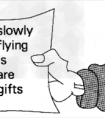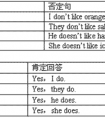用所给单词的适当形式填空。1.Look,thestudents(run)ontheplayground.2.He(read) abooklastnight.It'sveryinteresting.3.Mybrotherjumps(far) thanme.4.Jim(notdo)-六年级英语
副词和形容词一样,也有原级、比较级和最高级三个等级。
其构成方式有规则变化和不规则变化两种情况。
A、一般副词变为比较级其后直接加er,以e结尾的直接加r。
B、辅音字母+y结尾的,变y为i再加er;
重读闭音节词词尾只有一个辅音字母,双写辅音字母,再加er。
C、双音节词和多音节词,在词前直接加more。
D、不规则变化的副词:
badly → worse,far → farther(表距离),far → further(表程度)
well → better, little → less,much → more
副词比较级的用法:<?xml:namespace prefix = "o" ns = "urn:schemas-microsoft-com:office:office" />
1)单独使用:
Try to do better next time. 下次争取干好一点。
I had seen the film only a few days earlier. 我是几天前才看的这部电影。
He’ll come back sooner or later. 他迟早会回来的。
2)和than一起使用:
He swims better than I do. 他游泳游得比我好。
He works less than he used to. 他工作的时间比以前少了。
Can you do any better than that? 你能不能干的好一些?
3) 比较级前可有状语修饰:
You must work much faster. 你必须大大加快干活的速度。
He walked no further. 他没在往前走。
She could dance even more gracefully than a dancer. 她能比舞蹈演员跳的更美。
Helen came late, but her sister came still later. 海伦来晚了, 而她妹妹来得更晚。
考点名称:现在进行时,现在分词
现在进行时:
表示动作发生的时间是“现在”,动作目前的状态是“正在进行中”。所谓“正在进行中”,是指在谈到这件事的时候,这个动作还在进行中。
现在进行时由“系动词am/ is/ are+动词-ing形式”构成。
例:We are reading the text. 我们正在读课文。
My sister is working in a hospital. 我的妹妹在医院工作。
They are watching TV now. 他们正在看电视。
What are you doing, Li Lei? 你现在正在干什么,李雷?- 现在进行时的基本用法:
A表示现在( 指说话人说话时) 正在发生的事情。
例:We are waiting for you.
B. 表示现阶段正在进行的动作,说话时未必正在进行。
例:Mr. Green is writing another novel.
(说话时并未在写,只处于写作的状态。)
例:She is learning piano under Mr. Smith.
C.已经确定或安排好的但不确定会不会发生的将来活动。
I'm leaving for a trek in Nepal next week.(我下周要去尼泊尔旅行)
We're flying to Paris tomorrow.(我们明天乘飞机去巴黎) 一般现在时与现在进行时的区别:
一、准确理解两种时态的主要含义:
(一)一般现在时:
1.表示事物的本质特性或客观存在,没有时限性。
The table ____ soft。(feels) 表特性特征。
Japan ___ in the east of China。 (lives) 表客观事实
2.现阶段经常性、习惯性的行为,可带频率时间。
The shop closes at 7:30 p.m.
Father doesn’t smoke. (习惯)
3.表说话时的状态,感觉或结果,一般用状态动词,如:It doesn’t matter. Does it hurt? (感觉结果)
4.特殊用法:
-在条件、时间、让步从句中用现在时代替将来。
-If you go there,I’ll help you.
—用在begin,come,go,leave,return,open,close 等短暂谓语动词表规定计划。
The plane takes off at 11:30. (不受主观支配的计划)
-在剧本、解说、标题或there(here)开头的句中表进行
There goes the bell/Here comes Mr.Wang.
I declare the meeting opens.(正在宣布)
He meets the ball and hits back to No.2 (正在发生)
(二)现在进行时:
1.说话时正在发生,进行的动作
Look! Dark clouds are gathering . (正在发生)
2.表现阶段正在进行,但此刻不一定正在进行的事。
He usually gets up at 6:00,but this week he is getting up at 7:00. (现阶段正在进行,但说话时不一定在起床)
3.现在进行时的特殊意义
-表示主观打算常用于 go,come,leave,start,begin 等,位移、趋向动词。
How long are you staying here (准备停留)
-表示眼前刚过去的语意即“话音刚落”,适用于tell,say,talk,discuss ….
You don’t believe it You know I’m telling the truth.
-表示安慰、关心、喜欢、讨厌等感情色彩。
He is always making noises in class. (讨厌)
-在条件、时间、让步状语从句中表示将来正在进行。
Don’t bother him if he is reading this time tomorrow.二、严格区分进行时与一般时的语义
1.持续动词的一般时表持续情况,经常性,习惯性行为或客观存在的事实,进行时表暂时性或有限时刻的持续。
2.短暂动词的一般时叙述事实,特征,能力而短暂动作进行时描述反复发生,即将发生或刚开始行为。
3.短暂动词和静态动词一般时表示实际情况客观状态、结果、特征、特性,进行时表未完成含开始或渐进之意。
The bus stops. (车停了-事实)
The bus is stopping. (渐渐停下来)
I love the job. (静态事实)
I am loving the job. ( 渐渐爱上了)
4.come,go,leave,start,return,move,reach,sail,fall 等一般时态表客观规定计划,进行时表主观打算推测。
Flight 254 leaves at 5:30. (表客观规定计划)
The plane is taking off an hour later.(主观判断)
5.现在进行时带always,continually, constantly, for ever等频率副词表感情色彩,一般现在时则没有此用法。现在进行时的构成是:
主语+be+v.ing〔现在分词〕形式
人称
构成形式
第一人称单数
I+am+ing.
第一人称复数
We+are+ing.
第二人称单(复)数
You+are+ing
第三人称单数
He(She,it)+is+ing
第三人称复数
They+are+ing
句式
肯定句
主语+be(is/am/are)+现在分词
否定句
主语+be(is/am/are)+not+现在分词
一般疑问句
(is/am/are)+主语+现在分词
be特殊疑问句
特殊疑问词+相应be动词+主语+现在分词+Sth?
间接引语中改为过去进行时。
现在分词的构成:
- 最新内容
- 相关内容
- 网友推荐
- 图文推荐
| [家长教育] 孩子为什么会和父母感情疏离? (2019-07-14) |
| [教师分享] 给远方姐姐的一封信 (2018-11-07) |
| [教师分享] 伸缩门 (2018-11-07) |
| [教师分享] 回家乡 (2018-11-07) |
| [教师分享] 是风味也是人间 (2018-11-07) |
| [教师分享] 一句格言的启示 (2018-11-07) |
| [教师分享] 无规矩不成方圆 (2018-11-07) |
| [教师分享] 第十届全国教育名家论坛有感(二) (2018-11-07) |
| [教师分享] 贪玩的小狗 (2018-11-07) |
| [教师分享] 未命名文章 (2018-11-07) |






